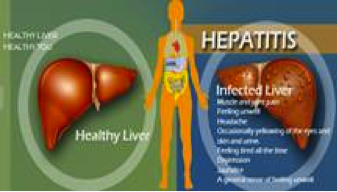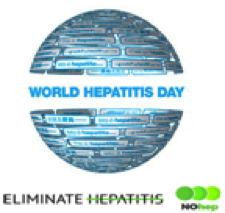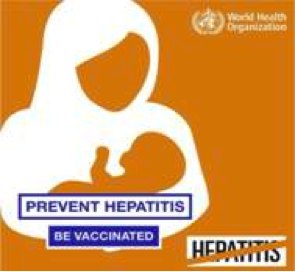
Hepatitis - an inflammatory disease of the liver is caused due to viral infection. In 2015, it led to nearly 1.34 million deaths worldwide (almost equivalent to that caused by tuberculosis); most of the viral hepatitis deaths being due to chronic liver disease/primary liver cancer (mortality due to cirrhosis - 720,000; hepatocellular carcinoma - 470,000). Over time, mortality due to viral hepatitis is yet on a rise.
 Viral hepatitis - a public health problem, can be caused by any of the known five hepatotropic viruses, namely - hepatitis A, B, C, D and E which are highly divergent in their structure, epidemiology, mode of transmission, incubation period, signs/symptoms, diagnosis, prevention and treatment options.
Viral hepatitis - a public health problem, can be caused by any of the known five hepatotropic viruses, namely - hepatitis A, B, C, D and E which are highly divergent in their structure, epidemiology, mode of transmission, incubation period, signs/symptoms, diagnosis, prevention and treatment options.
Globally, 240 million people are living with chronic hepatitis B and 130150 million with chronic hepatitis C infections. Global hepatitis report (2017) indicates that a large majority of these individuals lack access to lifesaving screening and treatment; as a result, majority are at risk of chronic liver disease and cancer leading to death.
Margaret Chan (DG, WHO) has urged all nations to take necessary steps for eliminating viral hepatitis as a public health threat by 2030 and free the world from this leading killer. The Sustainable Development Goal 3 – target 3 (SDG 3.3) calls for a specific action to combat viral hepatitis and water-borne/other communicable diseases. In India, viral hepatitis (A to E) remains a major public health challenge with intermediate to high endemicity for Hepatitis B; an estimated 40 million individuals are infected and the population prevalence being nearly 3-4%. However, there is a wide geographic variation in its prevalence – being the highest among natives of Andaman and Arunachal Pradesh.

World Hepatitis Day (28th July) which is celebrated every year, is an opportunity to step up national/international efforts for raising awareness as well as encouraging prevention, diagnosis and treatment of viral hepatitis at global level so as to achieve its elimination by 2030. Elimination of viral hepatitis has now been firmly put on the map. At the 69th World Health Assembly (Geneva), 194 governments adopted WHO’s first Global Health Sector Strategy on Viral Hepatitis (2016-2021) with a goal of eliminating hepatitis B and C in the next 13 years. The community responded by launching ‘NOhep’ – the first ever global movement to eliminate viral hepatitis by 2030. Theme for the year 2017 is ‘Eliminate Hepatitis’.
Despite variations in viral hepatitis antigens, during acute phase of the disease – most of the symptoms are common which include fever, fatigue, anorexia, nausea, vomiting, abdominal pain, chalky-grey stools, joint pain and jaundice. However, the mode of transmission varies; while hepatitis A and E are transmitted via oral-faecal route, hepatitis B, C and D are transmitted through unsafe blood transfusions or contaminated needles/syringes (particularly among the drug users), sexual-transmission or even mother-to-child transmission. Unlike A, B and C, viral hepatitis D and E are less common.
Hepatitis A virus (HAV) is often present in the faeces of infected individuals and is commonly transmitted through contaminated water/food and seldom through unsafe sex (incubation period: 15-50 days). In most cases, the infection is mild and the recovery is not only complete but it also confers long-term immunity. However, sometimes severe infections can be life threatening. The patients need appropriate dietary management and supportive treatment. Individuals residing in unsanitary environmental conditions are most vulnerable to this infection; though, safe and effective vaccines are available for its prevention.
Hepatitis B virus (HBV) is commonly transmitted through infected blood and semen/ other body fluids, particularly during the transfusion of contaminated blood/ blood products, use of contaminated needles/syringes (esp. in the case of drug users) or sexual contact with an infected person; and sometimes from infected mothers to infants at the time of birth With an incubation period of 45-160 days, this infection accounts for nearly 30% of liver cirrhosis and 40-50% of the liver cancer cases in India. The patients need regular monitoring to assess the progression of liver disease and some may also need antiviral drug treatment. In this case too, safe/effective vaccines are available to prevent the infection.
Hepatitis C virus (HCV) is also transmitted through infected blood and semen/other body fluids – mode of transmission and treatment options being almost similar to HBV (incubation period: 14-180 days). In 2014, Institute of Liver and Biliary Sciences reported an approximately 12 million individuals living with chronic Hepatitis C infection; and that the states of Punjab, Haryana, Andhra Pradesh, Puducherry, Arunachal Pradesh and Mizoram had a higher prevalence. However as yet, there is no vaccine available to provide protection against this virus.
Majority of the chronic Hepatitis B or C patients are incognizant of the infection; and are, thus, at a serious risk of developing cirrhosis or liver cancer.
Hepatitis D virus (HDV) – a RNA virus, requires hepatitis B virus for its replication; and therefore, occurs only in HBV infected individuals. Worldwide, nearly 15 million people are chronically co-infected with HDV and HBV; and this dual-infection can be much more serious registering worst outcomes. Mode of transmission is more or less similar to that of HBV except that the vertical transmission from mother-to-child is rather rare. Although, no effective anti-viral treatment is available for HDV, hepatitis B vaccine provides protection against this infection too.
Hepatitis E virus (HEV) is a small virus with single-stranded RNA genome which is mostly transmitted via contaminated water or food (incubation period: 2-10 weeks). Globally, about 20 million people are infected with HEV which is responsible for nearly 56,600 deaths/year. Though it occurs worldwide, its prevalence is highest in South East Asia. Pregnant women infected with hepatitis E (particularly in the 2nd/3rd trimester), are at an increased risk of acute liver failure, foetal loss and mortality. This infection is more common in immunosuppressed individuals - particularly those with organ transplant or on immunosuppressive drugs. The disease is usually self-limiting but in certain cases, it may lead to acute liver failure. Effective preventive approaches include quality water supply, proper human excreta/waste disposal, food safety and strict adherence to WASH practices. Though China has developed vaccine against HEV, it is yet not available in India/other countries.
India is among the 11 countries carrying nearly 50% of the global burden of chronic hepatitis. Realizing the dangers of hepatitis B in particular, in the year 2004, nearly 1.2 million Indian children were vaccinated with three doses of Hepatitis B under a pilot project. Thereafter, in 2007-08, our government included Hepatitis B vaccination under the expanded Universal Immunization Programme. Further, during the 12th Five Year Plan, GoI launched the National Programme for prevention and control of viral Hepatitis. Further, it instituted the National Viral Hepatitis Surveillance Programme (estimated budget: 30 crore) under the ages of National Centre for Disease Control which aimed at training the manpower/health care functionaries with special emphasis on training of trainers and development of IEC material for the community and the health-care providers.

While HAV vaccination strategies need to be revisited, India yet needs to prioritise the development/availability of HCV and HEV vaccines. Despite concerted efforts under Swacch Bharat Abhiyan, safe drinking water and adequate sanitation practices yet need to be accorded a high priority.
Observing utmost safety during injection/blood transfusion practices as well as ensuring safety of blood play an important role in the prevention of viral hepatitis. There is a dire need to position a dedicated trained public health functionary for addressing the issues relating to viral hepatitis.
Despite several challenges in the prevention, management and eradication of viral hepatitis in our country, joint coordinated action by all the stakeholders at a common platform and an early initiation of the comprehensive action plan would surely help in achieving our expected targets and making India a viral hepatitis free nation!!
(Author is Public Health Nutrition Consultant; Former Director, Institute of Home Economics, University of Delhi; Co-Author-Akanksha Jain. Courtesy PIB)